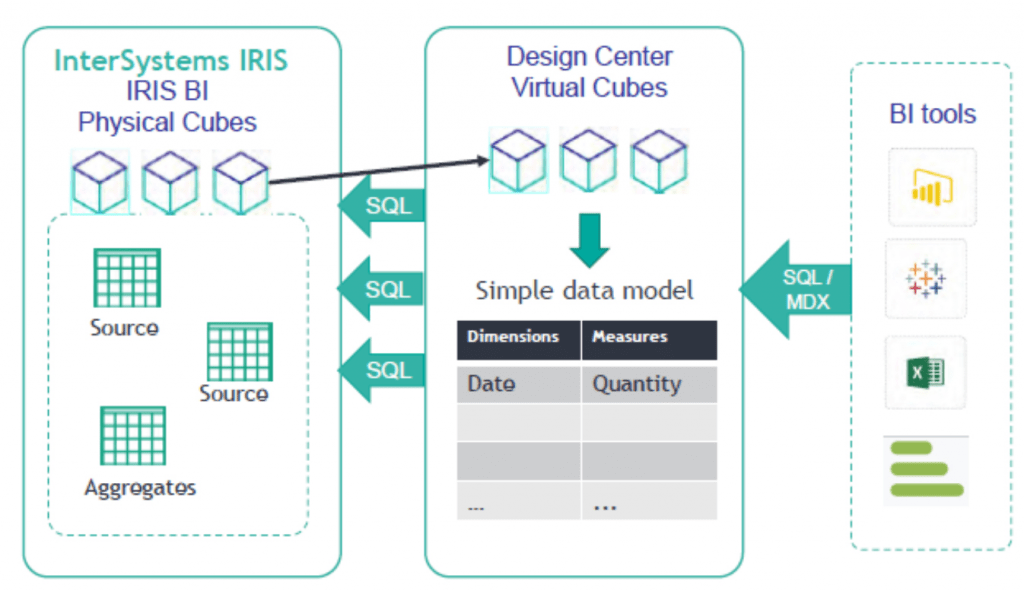InterSystems IRIS
Update solution on December 8, 2022

What is it?
InterSystems IRIS Data Platform was introduced in 2018 as a single, unified platform that acts as a replacement for, and evolution of, the company’s Caché database, Ensemble interoperability platform, and its various analytics offerings. InterSystems IRIS is available for on-premises, cloud-based, and hybrid deployments, with Kubernetes support included.
The major elements of InterSystems IRIS include a horizontally and vertically scalable, multi-model, transactional-analytic database with full ACID compliance and immediate consistency; scalable and distributed application server(s); an Eclipse-based development environment supporting several languages; a business process layer equipped with a rules engine, workflow and process orchestration; specific capabilities to support self-service-enabled analytics on structured or unstructured data; integration with streaming environments such as Apache Kafka; and on-demand access to data across multiple data sources via a data fabric architecture.
Customer Quotes
“We view InterSystems (IRIS) as a powerful and comprehensive platform for development. InterSystems provides all the capabilities we need to meet our business demands, in one seamless environment.”
CFAO
What does it do?
InterSystems IRIS stores data in multi-dimensional arrays. It supports relational, object (with full persistence, polymorphism, inheritance and so forth, and with no requirement for object-relational mappings), document, and multi-dimensional models, and you can implement any number of these within the same environment, with full interoperability across these projections, and without any duplication of data. Note that you can read an array either vertically or horizontally, which means that you only need to store data once to support both transactions and analytics. This is a major differentiator for InterSystems.
InterSystems IRIS scales to accommodate large workloads and data sets on commodity hardware, with both database and application servers scaling out horizontally. Application code is decoupled from the persistence of data, which allows application servers to scale horizontally, independently of the number of shard servers, and to distribute workloads automatically, thereby supporting both performance and consistency. The environment is configured so that nodes are designated as query, transactional or hybrid servers, in order to cater for different workload resource requirements. Data ingestion can be parallelised directly to each shard server, providing high-performance ingestion for streaming data, and analytic queries can be pushed down to partitioned or sharded data tables, further increasing performance and resource efficiency. The software can also make direct use of graphics processors for pipelining and so forth.

Fig 1 – InterSystems IRIS adaptive analytics
Analytics capabilities provided by InterSystems IRIS include a new IntegratedML feature that allows you to create and use predictive models using automated SQL functions; support for PMML (Predictive Modelling Mark-up Language) that allows native execution of predictive models developed in R, IBM SPSS and other environments; and a connector for leveraging Apache Spark-based machine learning and predictive models within the InterSystems IRIS environment (with parallel operations and high-speed connections from each of the shard servers into a Spark cluster). ‘Adaptive Analytics’ is another new feature – see Figure 1 – that allows you to expose analytic data only once, in such a way that it can serve multiple use cases simultaneously. This is accomplished using a ‘virtual cube’ data model, an alternative to the OLAP cube, that can be assembled using a drag and drop interface and deployed to various business intelligence and visualisation tools, such as Tableau, Power BI and Qlik (supported via an ODBC interface).
On that note, to facilitate the embedding of real-time business intelligence into operational applications, InterSystems IRIS includes a designer for creating dashboards; an analysis component, that can be employed by business users to explore and display relevant data; and an architect component, used to define your data model. For unstructured data, InterSystems IRIS includes natural language capabilities, and it supports Apache UIMA (Unified Information Management Architecture).
InterSystems IRIS provides several language options for development purposes. Apps that run on the platform directly can leverage SQL, Python, or ObjectScript (an in-house programming language) while external applications can also use Java, .Net or Node.js. Access to Python is a recent development and is a significant step forward in terms of access to trained developers (Python is more commonly used than ObjectScript) and programming libraries, without needing to sacrifice the performance, security, scalability and other benefits of an embedded approach. Notably, Python is considered a ‘full peer’ to ObjectScript, meaning that the two can essentially be treated as interchangeable and cross-compatible within InterSystems IRIS.
Why Should you care?
Hybrid real-time use cases are common in financial services (for instance, fraud detection), retail (customer personalisation), manufacturing/IoT (detecting errors, predictive maintenance), and various other industries. InterSystems IRIS not only caters to these environments, but it is going to be more cost efficient than many of its rivals, thanks to the fact that you only need to store your data once and in only one place.
Moreover, we consider InterSystems IRIS to be highly performant and scalable. It is, for instance, quite capable of processing transactions, indexing incoming data, and performing analytics on both real-time data and non-real-time data (that is, historical data and reference data) at scale and in real-time.
The platform also takes pains to make sure its analytics are not just highly effective in theory, but easy to build, access and use in practice. This is described by InterSystems as the ‘last mile’ of analytics, and positioned as an essential capability for generating real value from analytics technology. We are inclined to agree.
The Bottom Line
We are long-time fans of InterSystems products, and the recent improvements to InterSystems IRIS have certainly not dampened our enthusiasm: it remains a compelling hybrid transactional/analytic offering.
Related Company
Connect with Us
Ready to Get Started
Learn how Bloor Research can support your organization’s journey toward a smarter, more secure future."
Connect with us Join Our Community
